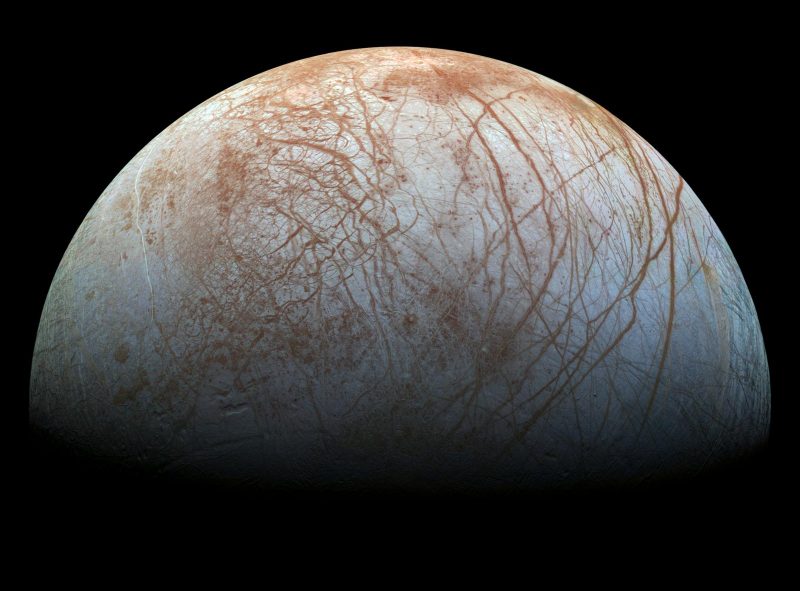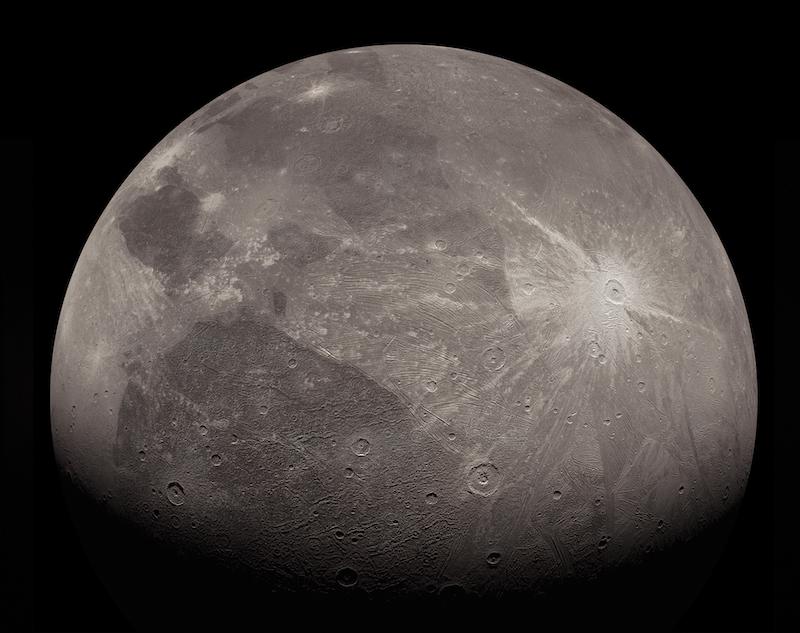
Many moons in the outer solar system have outer crusts of solid ice. But some features on these moons still puzzle scientists. Consider the reddish cracks on Jupiter’s moon Europa. Scientists say the red color likely comes from an unknown mixture of ice and salts, from within the moon. Now an international team of researchers has announced a possible reason: a newly discovered form of salty ice.
Researchers from the University of Washington led the new study and announced it on February 21, 2023. The Proceedings of the National Academy of Sciences of the United States of America (PNAS) published the peer-reviewed findings on February 21, 2023.
Last chance to get a moon phase calendar! Only a few left. On sale now.
New type of salty ice may exist on icy moons
Right now, scientists have only seen the newly discovered form of salty ice in the lab. The researchers created it by simulating the cold and high-pressure conditions found beneath the ice crust on the icy moons. But it may just be the answer that they’ve been looking for. It could explain the unusual streaks on Europa and features on other icy moons as well, if it does exist there.
The recipe for the substance is simple: sodium chloride, known as table salt (in its edible form), and water. Both are common, but the unique conditions inside the icy moons could produce a more exotic form of salty ice. Lead author Baptiste Journaux at the University of Washington explained:
It’s rare nowadays to have fundamental discoveries in science. Salt and water are very well known at Earth conditions. But beyond that, we’re totally in the dark. And now we have these planetary objects that probably have compounds that are very familiar to us, but at very exotic conditions. We have to redo all the fundamental mineralogical science that people did in the 1800s, but at high pressure and low temperature. It is an exciting time.
New kinds of sodium chloride hydrates
The exotic nature of the salty ice has to do with the assembly of its molecules. Typically, water and salts combine in cold temperatures to form a rigid, salty and icy lattice known as a hydrate. Hydrogen bonds hold that lattice together. Previously, scientists knew of only one other type of hydrate for sodium chloride. That one consists of one salt molecule for every two water molecules. But now, the lab simulations have produced two new kinds of sodium chloride hydrates.
While both hydrates are significantly different from what scientists normally see in nature (at least on Earth), they are also different from each other. One has two sodium chlorides for every 17 water molecules, but the other has one sodium chloride for every 13 water molecules. Could they explain the odd features on Europa and other icy moons? Journaux said:
It has the structure that planetary scientists have been waiting for.

Lab-created conditions common on icy moons
So, how did the researchers create the new salty ice? At synchrotron radiation facilities in France, Germany and the U.S., they compressed tiny amounts of salty water between two diamonds. The diamonds were also tiny, each about the size of a grain of sand. Incredibly, even in such a small space, the researchers were able to squeeze the salty water up to 25,000 times the standard pressure of Earth’s atmosphere. Journaux said:
We were trying to measure how adding salt would change the amount of ice we could get, since salt acts as an antifreeze. Surprisingly, when we put the pressure on, what we saw is that these crystals that we were not expecting started growing. It was a very serendipitous discovery.
What makes the simulated conditions in the lab so intriguing is that those conditions – extreme cold and high-pressure – are common on icy moons. The newly discovered kinds of salty ice should be able to form quite easily in those environments. The hidden oceans on these moons are unlike Earth’s open oceans. These oceans may be up to hundreds of miles deep, with three to six miles (five to 10 km) of ice on top of them. As Journaux noted:
Pressure just gets the molecules closer together, so their interaction changes; that is the main engine for diversity in the crystal structures we found.

Hydrates remain stable
Moreover, the new hydrates remained stable even after the scientists lessened the pressure. This shows that they could be present for long periods of time on icy moons. Journaux added:
We determined that it remains stable at standard pressure up to about -50 C. So if you have a very briny lake, for example in Antarctica, that could be exposed to these temperatures, this newly discovered hydrate could be present there.
Other applications for the salty ice
As well as helping to explain mysteries on faraway moons, the salty ice may have applications right here on Earth. This could include physical chemistry and energy research, which uses hydrates for energy storage (a type of thermal energy storage).
Salt hydrate technology uses the reaction energy created when salts are hydrated or dehydrated. Since 2016, researchers in several countries have been conducting experiments to determine the best type of salt or salt mixture to use.
NASA’s Europa Clipper mission, scheduled to launch in October 2024, will be able to take a closer look. With its multiple science instruments, it can conduct new analysis of the features on Europa where this salty ice may be present. Or, it could find something completely new! We will just have to wait to find out.
Bottom line: Researchers at the University of Washington have created new forms of salty ice hydrates. They might explain unusual surface markings on icy moons like Europa.
The post Icy moons’ puzzling features may be due to salty ice first appeared on EarthSky.
from EarthSky https://ift.tt/WNoiCU4

Many moons in the outer solar system have outer crusts of solid ice. But some features on these moons still puzzle scientists. Consider the reddish cracks on Jupiter’s moon Europa. Scientists say the red color likely comes from an unknown mixture of ice and salts, from within the moon. Now an international team of researchers has announced a possible reason: a newly discovered form of salty ice.
Researchers from the University of Washington led the new study and announced it on February 21, 2023. The Proceedings of the National Academy of Sciences of the United States of America (PNAS) published the peer-reviewed findings on February 21, 2023.
Last chance to get a moon phase calendar! Only a few left. On sale now.
New type of salty ice may exist on icy moons
Right now, scientists have only seen the newly discovered form of salty ice in the lab. The researchers created it by simulating the cold and high-pressure conditions found beneath the ice crust on the icy moons. But it may just be the answer that they’ve been looking for. It could explain the unusual streaks on Europa and features on other icy moons as well, if it does exist there.
The recipe for the substance is simple: sodium chloride, known as table salt (in its edible form), and water. Both are common, but the unique conditions inside the icy moons could produce a more exotic form of salty ice. Lead author Baptiste Journaux at the University of Washington explained:
It’s rare nowadays to have fundamental discoveries in science. Salt and water are very well known at Earth conditions. But beyond that, we’re totally in the dark. And now we have these planetary objects that probably have compounds that are very familiar to us, but at very exotic conditions. We have to redo all the fundamental mineralogical science that people did in the 1800s, but at high pressure and low temperature. It is an exciting time.
New kinds of sodium chloride hydrates
The exotic nature of the salty ice has to do with the assembly of its molecules. Typically, water and salts combine in cold temperatures to form a rigid, salty and icy lattice known as a hydrate. Hydrogen bonds hold that lattice together. Previously, scientists knew of only one other type of hydrate for sodium chloride. That one consists of one salt molecule for every two water molecules. But now, the lab simulations have produced two new kinds of sodium chloride hydrates.
While both hydrates are significantly different from what scientists normally see in nature (at least on Earth), they are also different from each other. One has two sodium chlorides for every 17 water molecules, but the other has one sodium chloride for every 13 water molecules. Could they explain the odd features on Europa and other icy moons? Journaux said:
It has the structure that planetary scientists have been waiting for.

Lab-created conditions common on icy moons
So, how did the researchers create the new salty ice? At synchrotron radiation facilities in France, Germany and the U.S., they compressed tiny amounts of salty water between two diamonds. The diamonds were also tiny, each about the size of a grain of sand. Incredibly, even in such a small space, the researchers were able to squeeze the salty water up to 25,000 times the standard pressure of Earth’s atmosphere. Journaux said:
We were trying to measure how adding salt would change the amount of ice we could get, since salt acts as an antifreeze. Surprisingly, when we put the pressure on, what we saw is that these crystals that we were not expecting started growing. It was a very serendipitous discovery.
What makes the simulated conditions in the lab so intriguing is that those conditions – extreme cold and high-pressure – are common on icy moons. The newly discovered kinds of salty ice should be able to form quite easily in those environments. The hidden oceans on these moons are unlike Earth’s open oceans. These oceans may be up to hundreds of miles deep, with three to six miles (five to 10 km) of ice on top of them. As Journaux noted:
Pressure just gets the molecules closer together, so their interaction changes; that is the main engine for diversity in the crystal structures we found.

Hydrates remain stable
Moreover, the new hydrates remained stable even after the scientists lessened the pressure. This shows that they could be present for long periods of time on icy moons. Journaux added:
We determined that it remains stable at standard pressure up to about -50 C. So if you have a very briny lake, for example in Antarctica, that could be exposed to these temperatures, this newly discovered hydrate could be present there.
Other applications for the salty ice
As well as helping to explain mysteries on faraway moons, the salty ice may have applications right here on Earth. This could include physical chemistry and energy research, which uses hydrates for energy storage (a type of thermal energy storage).
Salt hydrate technology uses the reaction energy created when salts are hydrated or dehydrated. Since 2016, researchers in several countries have been conducting experiments to determine the best type of salt or salt mixture to use.
NASA’s Europa Clipper mission, scheduled to launch in October 2024, will be able to take a closer look. With its multiple science instruments, it can conduct new analysis of the features on Europa where this salty ice may be present. Or, it could find something completely new! We will just have to wait to find out.
Bottom line: Researchers at the University of Washington have created new forms of salty ice hydrates. They might explain unusual surface markings on icy moons like Europa.
The post Icy moons’ puzzling features may be due to salty ice first appeared on EarthSky.
from EarthSky https://ift.tt/WNoiCU4

Aucun commentaire:
Enregistrer un commentaire